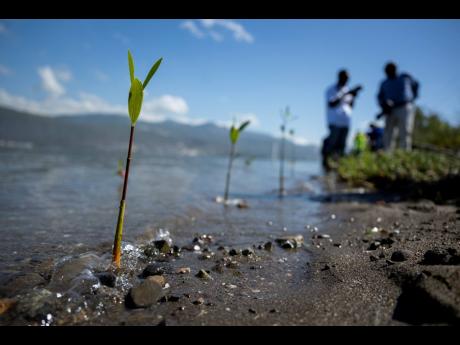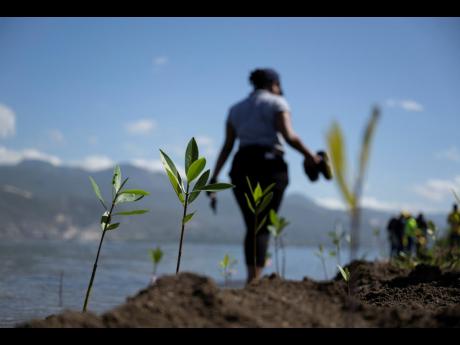JPS Foundation commits to replenishing mangroves at Palisadoes
Although hundreds of red mangrove saplings have been planted in recent years to replenish the dying mangrove population along the Palisadoes strip in Kingston, those efforts have gone in vain as pollution and lack of maintenance have caused many of the young trees to wither.
On Thursday, while the world observed World Wetlands Day, the Jamaica Public Service (JPS) Company Limited, through its Foundation, embarked on an exercise to replenish the mangroves along the Palisadoes strip.
The company also donated the first $7 million needed for the National Environment and Planning Agency (NEPA) Adopt-a-Mangrove programme. Those funds will be disbursed over three to five years, based on demand, as work progresses to maintain the mangroves at Sturridge Park along the Palisadoes strip.
JPS Volunteers on Locations to Service planted 50 red mangroves on Thursday morning, and earned the platinum adoptee spot with NEPA.
The light and power company will also return with the human capital needed to maintain the mangroves and manage the adopted location.
Michel Gantois, president and chief executive officer of the JPS, told The Gleaner that the project forms part of the company’s continued effort to remain as a good corporate citizen.
“As a country, we have not done enough in preserving the environment, and we see it here every day, because we have a lot of trash coming in the river, in the port; and here particularly destroying the mangroves and therefore destroying the livelihood of the communities,” Gantois added.
Anthony McKenzie, director, environmental management and conservation at NEPA, said that NEPA had planted the plot before along, with volunteers, but a lack of maintenance caused the young trees to dry up. He said, now that the JPS has committed five years to this maintenance process, the new timeline is sufficient for the mangroves’ growth.
“This site is particularly challenging because of the solid waste that comes across, and so we have to maintain a barrier and then do regular cleaning of the area, and, of course, some plants will die. So we have to replant,” McKenzie said.
Commenting on maintenance costs, he said an estimated 0.1 hectare will cost about $4 million to maintain over five years.
“This [the location adopted by JPS] is about 0.2 to 0.3 hectares ... . We expect that, over the next 10 years, when you drive along the road, you’ll see the plants tall and providing the function that they naturally provide,” he said.
NEPA’s Adopt-a-Mangrove programme is a five-year initiative which will support the ecosystem conservation and restoration programmes. These programmes aim to protect and restore Jamaica’s wetlands as the country seeks to sustain and enhance ecological values and functions.
The adoption of the Sturridge Park plot is envisioned to be a catalyst for further conservation partnerships across the length and breadth of Jamaica.
Monique Curtis, manager, ecosystem management branch at NEPA, said that it was important for the Sturridge Park plot to be considered for the Adopt-a-Mangrove programme, given its status as a Ramsar site, which is a wetland area designated to be of international importance under the Ramsar Convention.
“I think it signals a start; a launching pad for what we have here today, which is the launch of the Adopt-a-Mangrove programme, which is an initiative that the National Environment and Planning Agency is hoping to engage partnership in restoration activities. So we have been doing restoration activities across the island, but it’s also now important for us to engage the relevant players in our efforts to spread this activity in terms of accelerating the restoration of our degraded sites,” Curtis told The Gleaner.
She also stated that the agency will implement preservation strategies for the growth of the mangroves in years to come, and not have a repeat of its loss, as was the case with previous projects along the same shoreline.
“We will be doing various things to stem the negative impact of the environment here, so we will be removing solid waste throughout the project. We will be erecting barriers to safeguard mangrove seedlings that we will also be planting out,” she said.
Curtis noted that there are three other areas along the Palisadoes strip that NEPA is seeking other organisations to adopt as well.
“There are four areas ... . We do have other initiatives that were previously launched, so, going along the Palisadoes towards Harbour Head, we do actually have a project in collaboration with the Centre of Marine Sciences and the Port Royal Marine Lab of The University of the West Indies. That was actually launched in 2022, in celebration of World Environment Day, and, at that point in time as well, we also launched that project to align with the United Nation’s Decade on Ecosystem Restoration,” she said.
The Palisadoes-Port Royal Protected Area (P-PRPA) was declared on September 18, 1998 and spans an area of approximately 7,523 hectares. The combination of its natural, historical, cultural and economic resources has produced an area with unique characteristics.


